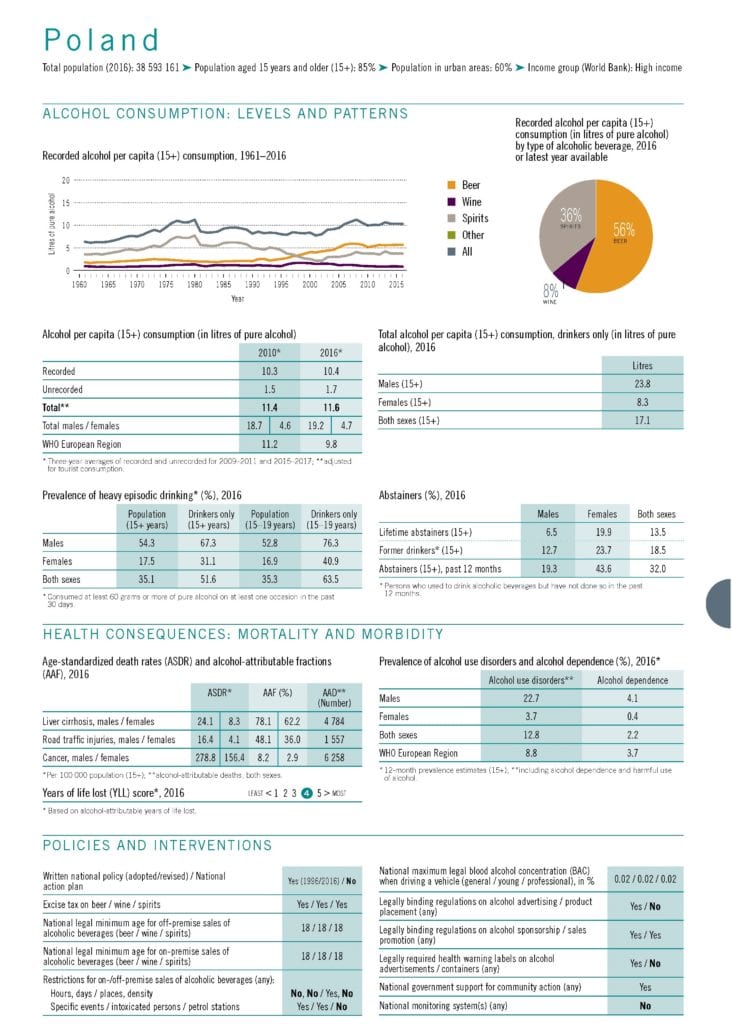According to the State Agency for the Prevention of Alcohol-Related Problems (PARPA), alcohol consumption increased by 0.23 litres per capita in 2019 compared to 2018. The increase brought the Polish alcohol consumption to 9.78 litres of pure alcohol per person, the highest it has been since 1993.
Consumption of liquor is reported as the major contributor to this increase. In terms of pure liquor intake, consumption increased from 3.3 litres in 2018 to 3.7 litres in 2019. The amount of beer consumed has decreased from 100.5 litres in 2018 to 97. 1 litres in 2019.
Experts are concerned about the growing popularity of small alcohol bottles called “monkeys”. They are small bottles of liquor, often colorful and flavored, and easily, widely and cheaply available. Reportedly, sales of these small bottles have not decreased even during the ongoing COVID-19 pandemic. As Movendi International reported last year, monkeys are fueling heavy alcohol consumption in Poland.
These small alcohol bottles give consumers a false sense of control over their alcohol use. In 2017 there were 40 different taste varieties of “monkeys”. It is estimated that 3 million people buy them in Poland on a daily basis and 600,000 purchase these bottles twice a day. Yearly, over 1 billion ‘monkeys’ are sold.
Alcohol harm in Poland
As World Health Organization (WHO) data from the 2018 Global Alcohol Status Report shows, Poland belongs to the countries in the world with a high rate of years of life lost due to alcohol. While almost a third of the Polish population lives free from alcohol, the burden of alcohol harms on people, communities and society is still massive.
- More than 6,000 cancer deaths are due to alcohol in Poland.
- More than 4,500 liver cirrhosis deaths are caused by alcohol.
- 22.7% of Polish men have an alcohol use disorder.
- 63.5% of Polish alcohol consuming youth between 15 and 19 years of age engage in binge alcohol use.
At the same time, the WHO overview shows that alcohol legislation in Poland remains inadequate to respond to this heavy burden. Alcohol policy can clearly be improved. There are only insufficient availability regulations, for examples regarding on- and off-premise alcohol retail. And there are only weak alcohol marketing regulations. The WHO best buy measures including increasing alcohol taxes, regulating availability and banning alcohol advertising, promotions and sponsorship are important tools available for countries like Poland to promote health and wellbeing.
Recently Poland has taken steps to improve alcohol taxation in the country targeting the “monkey” problem. As Movendi International reported in February 2020, Poland’s lower house in the Parliament adopted a bill to tax small bottles of alcohol (up to 300ml) and sugary drinks. The Minister of Health reported that the funds from these taxes will go into health promotion and addressing non-communicable diseases (NCDs).
Tackling alcohol advertising in the country is a WHO recommended effective policy best buy solution which Poland can invest in. Currently alcohol advertising is self-regulated and often exploited by Big Alcohol to run unethical advertising campaigns and increase heavy alcohol consumption in the country.
In 2013, Poland voluntarily committed at the WHO to reach a 10% reduction in overall alcohol consumption by 2025. The country is clearly off track in reaching their target. If stronger policy action is not taken this target will remain an unfulfilled promise.
